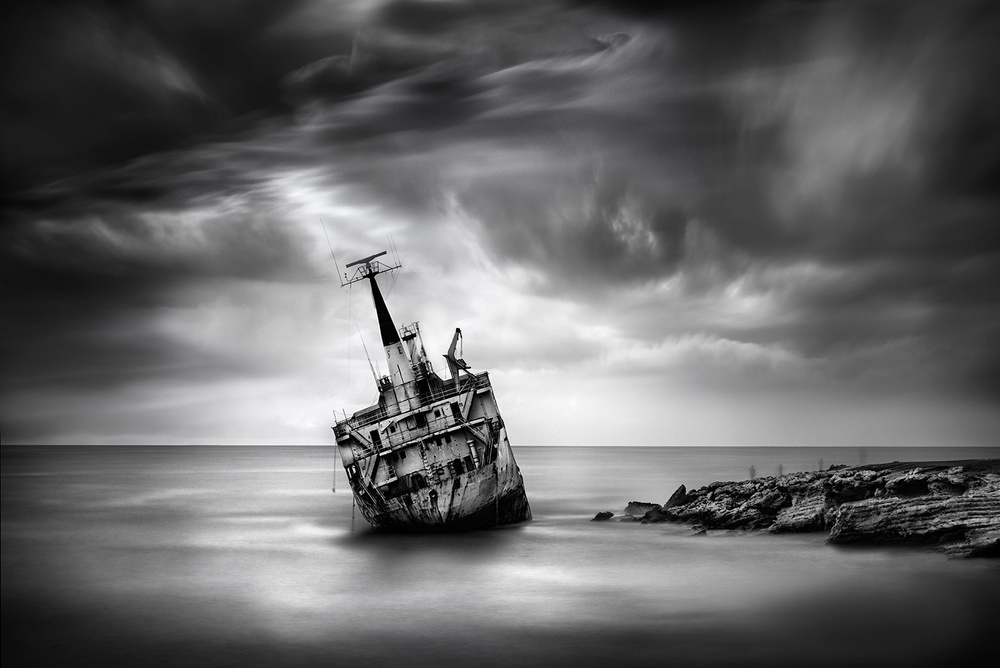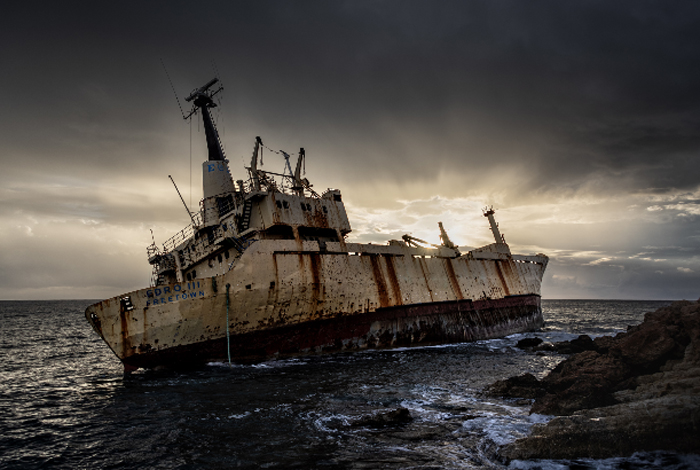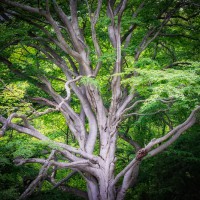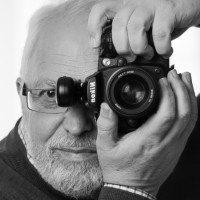SEARCH






|
|
|
|


by Editor Michel Romaggi in collaboration with the author George Digalakis
Published the 26th of November 2020

'the long journey' by George Digalakis
Dear George, your pictures are soft, velvety ones, often tainted with a bit of nostalgic mood. This Black and white seaside with a smooth long exposure sea and half-sunken wreck emerging, with a dusky sky as a background, and ghosts on the rocks, offers us a peaceful silent and moody picture.
We would be very pleased if give us some elements to understand how you created this excellent image.
Can you tell us some more about the location?
The image was taken in Peyia (Pegeia), a town in the Paphos district of Cyprus. The location is a 15 min drive from the centre of Paphos. The shipwreck is the cargo ship EDRO III (Sierra Leone-flagged), which ran aground off Peyia in 2011.
How do you usually find your subjects?
A place I have visited, heard about, or just seen in images of other photographers is usually the motivation for a photo outing to a specific place. On other occasions, an object, like a tree or rock, encountered in my daily life, a piece of literature I’ve read, or just an idea or even a dream can be the trigger for the initial concept of work. There is no need to travel to exotic places to find interesting subjects though. Fine Art is mainly about the ability to create mood and convey feelings to the viewer. I often find inspiration in the ordinary - elements ignored by other photographers and indifferent to most people; subjects that convey feelings of loneliness, isolation, and melancholy; bare trees in the water, old piers, lonely rocks, etc. When travelling to a specific place I use to perform a virtual exploration using Google maps and/or Google Earth. I find it useful not only for finding interesting subjects, but also to study these subjects for interesting angles, background distractions, vantage points, spots to place the tripod, etc., so I am as much prepared as possible. And of course, I always leave room for surprises; you never know what you are going to find on location. Many times, we lose interesting opportunities, because we are so much preoccupied with a preconceived mental concept about what is worth photographing in a certain location.
Why did you choose for a BW long exposure shot?
Timelessness! Unlike painting, classic photography was born and grew in Black and White. The days of Henri Cartier-Bresson and other masters of photography that we admire today are associated with black and white images and quality photography. In other words, B&W conversion gives a timeless quality to the images and, for reasons connected to the roots and traditions of classic photography, offers a greater visual delight. I believe that both LE and BnW move the image away from reality, from a specific time and place, and give it a timeless character.
Maybe because of the influence of classic (film) black and white photography, we tend to react emotionally more when we see an image in black and white. Fine art is just about emotions and BnW helps create atmosphere and drama! Another reason I work in black and white is that I consider colour to be a distraction from the main building blocks of photography: shape, lines, forms, and tones. Additionally, B&W is subconsciously associated with certain moods like melancholy, loneliness, fear, sadness, isolation, etc., which suits my style and character. Now, about LE; with the use of the long exposure technique, I introduce the sense of passing time, while at the same time eliminate the details from the background, thus highlighting my subjects and creating a surreal mood. LE obscures reality and transports the viewer into a dreamy world, in a different space and time. These emotions are not created by the technique alone, but it certainly helps me produce the work I have imagined. And of course, light. Light is different in a long exposure – much softer with less contrast as the boundaries of the shadow areas are moving.
I like to include here another “normal” image of the same subject, taken only few minutes before the long exposure one, so that the readers could compare the two images.
I definitely prefer the B&W one, which in my eyes is about the soul of the shipwreck. The second one is just about sunset colours.

What settings did you use?
As it is obvious from the colour image above, since the image was taken during sunset, there was an extreme tonal range, beyond the capabilities of the sensor of my camera.
To avoid areas without details – absolutely white or black, I had to take 2 exposures, one for the sky and one for the foreground and the subject, which I later blended in PS.
So, I used 2 ND and 1 Graduated ND filter (14 stops in total) and the settings of my camera were:
72mm, f/11, ISO 65. For the 1st capture (foreground) the exposure time was 180 sec and for the 2nd capture (sky) 60 sec.
Your skies are often remarkable. Are there any special conditions that you prefer to take your photos and get the result you want?
Weather conditions are a major factor for a successful outing. I prefer low contrast scenes while moving clouds are an essential part of my Long Exposure images, and therefore checking a meteorological site is a prerequisite to my preparation. Heavy clouds are my preferred weather conditions, thus a forecast for rain is what I am usually looking for, as I have taken my best shots in the interval between heavy rain showers with fast-moving storm clouds. And I prefer to shoot early in the morning or late in the evening with the sun close to the horizon levels. Even if there is no colour in my images, I have found that with the sun low on the horizon, there is more contrast and drama on the surface of the cloud. Having a brighter part of the background around the horizon also helps me separate and enhance my subjects.
Do you process your images ?
The short answer is “Yes”.
What I photograph is only the RAW material, which I transform to create unique artwork, representing my feelings and vision. It all starts with an impression, which is then mentally transformed into an idea about the final image. I always try to capture the image in a way that is as close as possible to this idea, but usually, the image must go through different phases of transformation in order to exactly match my initial vision.
Nothing seen in the scene is taken for granted, being its colour, form, light... The colours are there to be converted, the shapes to be transformed and the light to be created a-new and used exactly where I want it to be. I want to express not reality, but how I feel about this reality; to express an idea, a message, or an emotion.
Can you tell us about your passion for photography and about yourself?
A medical doctor by profession, I’ve been an art lover and a fanatical museum goer for as long as I can remember, but I have never thought of myself as an artist. My first contact with photography was back in 1974 when I received a “Nettar” as a gift from my father. I used to love the image-making process and the darkroom environment in the film era, but I viewed it only as a hobby. However, back in 2011 I decided to study photography, and became acquainted with classic and contemporary photographers; I realized photography could enable me to express my inner world. What attracted me to photography is its ability to create beauty in ordinary places and order out of the disordered world. The event that changed my attitude to photography was back in 2015 when winning the silver medal in the Px3 competition made me realize that my images can stand in the international arena and most importantly affect other people. Whilst typically a hobby, since I am an amateur photographer with a day-to-day job, it is in fact a great passion with a most decisive role in my life. I spend almost all my free time in activities connected with photography, and even my vacations are planned based on photographic opportunities.
Thank you very much for sharing your artistic vision with us, dear George.
 | Write |
 | Michel Romaggi CREW Thank you, Yvette.
Actually, it's my pleasure to learn from 1x's great photographers.;-)
I Like to share this with all members. |
 | Cristiano Giani PRO Very inspirational, George. Many thanks for sharing..... |
 | Yvette Depaepe CREW Thank you, George, for this insightful interview/tutorial. I fully enjoy it and like to thank Michel too for his fine job leading new tutorials so often. Cheers, Yvette |
 | Eduardo Blanco García PRO Excelente!!!!
|